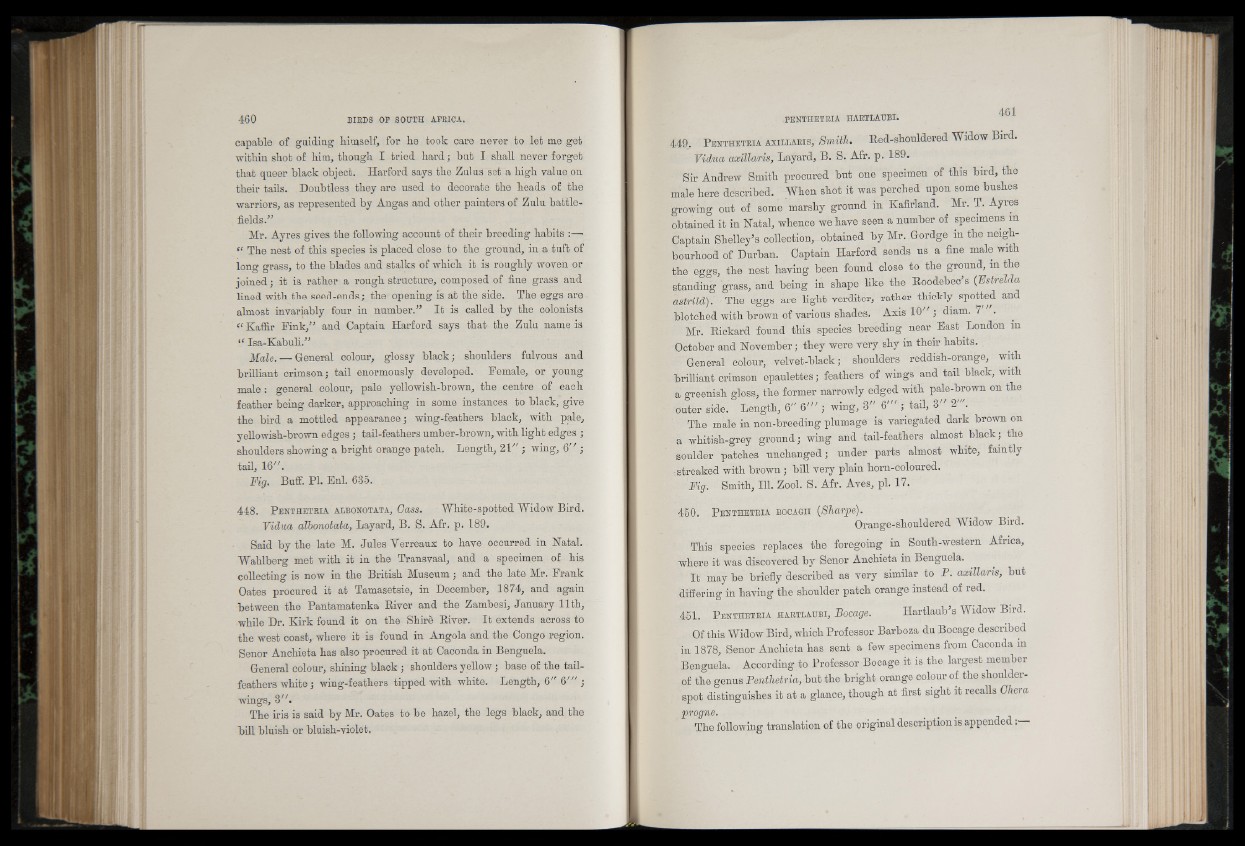
capable of guiding himself, for he book care never to let me get
within shot of him, though I tried hard; but I shall never forget
that queer black object. Harford says the Zulus set a high value on
their tails. Doubtless they are used to decorate the heads of the
warriors, as represented by Angas and other painters of Zulu battlefields.”
Mr. Ayres gives the following account of their breeding habits :—
“ The nest of this species is placed close to the ground, in a tuft of
long grass, to the blades and stalks of which it is roughly woven or
joinedj it is rather a rough structure, composed of fine grass and
lined with the seed-ends; the opening is at the side. The eggs are
almost invariably four in number.” It is called by the colonists
“ Kaffir Fink,” and Captain Harford says that the Zulu name is
“ Isa-Kabuli.”
Male. — General colour, glossy blackj shoulders fulvous and
brilliant crimson] tail enormously developed. Female, or young
male: general colour, pale yellowish-brown, the centre of each
feather being darker, approaching in some instances to black, give
the bird a mottled appearance ] wing-feathers black, with pale,
yellowish-brown edges j tail-feathers umber-brown, with light edges ]
shoulders showing a bright orange patch. Length, 21" ; wing, 6" ;
tail, 16".
Fig. Buff. PI. Enl. 635.
448. P e n t h e t r ia albo n o ta ta , Gass. White-spotted Widow Bird.
Vidua albonotata, Layard, B. S. Afr. p. 189.
Said by the late M. Jules Verreaux to have occurred in Natal.
Wahlberg met with it in the Transvaal, and a specimen of his
collecting is now in the British Museum; and the late Mr. Frank
Oates procured it at Tamasetsie, in December, 1874, and again
between the Pantamatenka River and the Zambesi, January 11th,
while Dr. Kirk found it on the Shire River. I t extends across to
the west coast, where it is found in Angola and the Congo region.
Senor Anchieta has also procured it at Caconda in Benguela.
General colour, shining black ] shoulders yellow; base of the tail-
feathers whitej wing-feathers tipped with white. Length, 6" 6"' ]
wings, 3 .
The iris is said by Mr. Oates to be hazel, the legs black, and the
bill bluish or bluish-violet.
449. P e n t h e t r ia a x il l a r is , Smith. Red-shouldered Widow Bird.
Vidua axillaris, Layard, B. S. Afr. p. 189.
Sir Andrew Smith procured but one specimen of this bird, the
male here described. When shot it was perched upon some bushes
growing out of some marshy ground in Kafirland. Mr. T. Ayres
obtained it in Natal, whence we have seen a number of specimens m
Captain Shelley’s collection, obtained by Mr. Gordge m the neighbourhood
of Durban. Captain Harford sends us a fine male with
the eggs, the nest having been found close to the ground, m the
standing grass, and being in shape like the Roodebec’s (FstreUa
astrild). The eggs are light verditer, rather thickly spotted and
blotched with brown of various shades. Axis 10 ' ] diam.
Mr. Rickard found this species breeding near East London m
October and November ] they were very shy in their habits.
General colour, velvet-black j shoulders reddish-orange, with
brilliant crimson epaulettes ] feathers of wings and tail black, with
a greenish gloss, the former narrowly edged with pale-brown on the
outer side. Length, 6" 6 '" j wing, 3" 6"' j tail, 3 2 .
The male in non-breeding plumage is variegated dark brown on
a whitish-grey ground] wing and tail-feathers almost black j the
soulder patches unchanged] under parts almost white, faintly
-streaked with brown ] bill very plain horn-coloured.
Fig. Smith, 111. Zool. S. Afr. Aves, pi. 17.
450. P e n t h e t r ia b o c a o ii [Sharpe).
Orange-shouldered Widow Bird.
This species replaces the foregoing in South-western Africa,
where it was discovered by Senor Anchieta in Benguela.
It may be briefly described as very similar to P. axillaris, but
differing in having the shoulder patch orange instead of red.
451. P e n t h e t r ia h a r t l a u b i, Bocage. Hartlaub’s Widow Bird.
Of this Widow Bird, which Professor Barboza du Bocage described
in 1878, Senor Anchieta has sent a few specimens from Oaconda in
Benguela. According to Professor Bocage it is the largest member
of the genus Penthetria, but the bright orange colour of the shoulder-
spot distinguishes it at a glance, though at first sight it recalls Ghera
progne.
The following translation of the original description is appended: